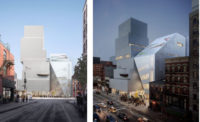The Metropolitan Museum of Art announced Monday that it is overhauling the Michael C. Rockefeller Wing at the southern end of its massive building along Manhattan’s Fifth Avenue. The wing contains 40,000 square feet of galleries devoted to the Arts of Africa, Oceania, and the Americas (AAOA). The institution also revealed the new design, which maintains the same footprint but introduces a completely new look and layout. Los Angeles– and New York–based firm wHY was chosen for the $70 million project following two rounds of interviews with six leading international firms. The decision was made long before the Met’s new director, Max Hollein, took office this August. The announcement however, was postponed until now as the museum sorted out its troubled finances and considered the future of several architectural interventions, including the postponed $600-million David Chipperfield project for the Modern wing, also on the southern end of the building.
According to the Met, the selection of wHY was made on the basis of completed projects and how its past focus might benefit “this very demanding, sculpture-centric initiative.” wHY, of course, has become a darling of the art scene, completing a series of gallery and museum projects—both new build and renovation—throughout the US. Led by Kulapat Yantrasast, the now 32-person interdisciplinary practice first made a name for itself over a decade ago with the redesign of several galleries at the Art Institute of Chicago and a new building for the Grand Rapids Art Museum. In 2016, wHY completed the Speed Art Museum in Louisville, Kentucky. Since then, the firm has been on a roll. Last spring, wHY converted a long-vacant masonic temple into the Marciano Art Foundation in Los Angeles. Last September—the same month that the Asian Art Museum in San Francisco unveiled wHY’s design for a renovation and expansion—the firm was tapped to renovate the Northwest Coast Hall at the American Museum of Natural History in New York. But Yantrasast believes it was their work at the Harvard Art Museums (2014), handling elements like casework, organization, and sightlines within the galleries, that landed the firm this job.
“The most important thing is to connect these galleries to the rest of the museum,” says Yantrasast. For the Africa and Oceania galleries, wHY has designed curved wood ceilings inspired by the vaulted ceilings of the museum’s Great Hall and its Greek and Roman galleries. The Americas gallery features stone platforms that match the pink and grey granite of the existing floor. The nearly 40-year-old glass curtain wall of that space—which mirrors another glass curtain wall on the north end, all part of Roche Dinkeloo’s decades-long overhaul of the Met beginning in 1967—will be entirely replaced with a new system. The new curtain wall will look similar to what’s there now, according to Yantrasast, but is expected to perform better in terms of waterproofing and reducing light transmission. Even though a majority of the AAOA collection is sculpture, the pieces are light sensitive due to the wood and organic materials they comprise.
In the meantime, the Met continues to work on the plans for the Modern wing, which will be preceded by this work on the Rockefeller wing, set to begin in 2020. Says Met president and CEO Daniel H. Weiss, “While these projects are independent of one another and will be led by separate architecture firms, the design and curatorial teams are working closely together as the wings are adjacent to one another, and, more importantly, the art of these areas share multiple narratives.”








Post a comment to this article
Report Abusive Comment